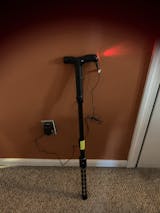Turkey hunting is the ultimate stalk, locate, set-up and ambush hunt. And, the key to the success is having the best turkey call. Turkey calling is one of the less difficult game calls to accomplish because most of the hen turkey sounds can be made with a large call styles. The diaphragm call is widely used because of its wide range of sounds and hands free operation. Using the mouth held diaphragm call offers a great advantage when Mt Tom comes walking into range. Turkey's have keen eye sight and will high tail it at the slightest movement. So have both hands free to make a quick, accurate shot is imperative. But, the diaphragm turkey call is rather difficult to execute. These calls are a little tricky and require a certain amount of coordination to manipulate the call with your tough and at the same time provide the correct amount of air to get the desired sounds.
The striker call is much easier to operate, however, it generally requires both hands to operate and producing turkey flushing movement. This call consist of a striker, rod device, and a surface, glass or otherwise. The striker is used to "strike" the surface creating a sound similar in creation to chalk on a black board, but with designed to produce turkey sounds. Hunters using the striker type call will need to practice to learn proper technique, pressure and duration of the strike and they will need to be more concerned about concealment because the hand movement required to make the call will bust you.
A third and much easier call to use is the box call. Many hunters can quickly learn to produce adequate turkey sounds on a box style call. It is not unusual to get a satisfactory turkey sound out of a box call the first time the hunter give it a try. But again, the box call requires hand movement which must be concealed for higher success ratios.
Turkey hunters use other calls in the quest for Ole Tom. One such call is the locator call. The locator call, as the name implies, is used to locate gobblers in order for the hunter to approach the turkeys location and get close enough to set-up the hunt and the call the gobbler into range. Most locator calls are mouth operated and create the sounds of anything but turkeys. It seems that Ole Tom will gobble when he hears the sounds of owls, hawks, crows and other predators. So, by finding suitable turkey habitat or signs and using a locator call, you'll get a goober to reveal himself with a loud gobble and the hunt is on.
Calling turkeys is an exciting and rewarding hunt. Find the right turkey call for your ability and practice schedule and score a long beard like a pro.


